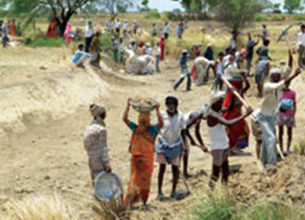Social security and the story of two Budgets
Why in News?
- Provision for social welfare schemes in Budget 2023-24.
Details:
- It is argued that despite promising ‘a better quality of life and life of dignity’, the Budget 2023-24 has made severe cuts in various social security and welfare schemes.
- For example, low allocation to food security and the Mahatma Gandhi National Rural Employment Guarantee Act (MGNREGA) has undermined the already precarious lives of many poor people.
- Another major example is the National Social Assistance Programme (NSAP) which has remained constant at around ₹9,000 crores and is steadily reducing in real terms.
- In 2023-24 itself, it saw a reduction of ₹16 crores (₹9,636.32 crores).
- Since 2007, social security pension under the NSAP has remained frozen at a low sum of ₹200 for the elderly and ₹300 per month for widows and persons with disabilities.
- Additionally, only those who are Below Poverty Line (BPL) as per the census 2001 are given pensions.
- Such a reduction disregards the “inclusive growth” model.
- The share allotted to NSAP (as a percentage of the total expenditure) in the budget has constantly decreased from 0.58% in FY2014-15 (BE) to 0.21% in Budget 2023-24.
National Social Assistance Programme (NSAP):
- It is a centrally sponsored social security scheme that provides non-contributory income security to the elderly, widows, and persons with disabilities belonging to “BPL families”.
- There are three main schemes under this programme:
- Indira Gandhi National Old Age Pension Scheme (IGNOAPS)
- Indira Gandhi National Widow Pension Scheme (IGNWPS)
- Indira Gandhi National Disability Pension Scheme (IGNDPS)
- State governments are also encouraged to match the amount of the central contribution under the NSAP’s guidelines.
Case Study of Rajasthan:
- Rajasthan government has proposed (in State Budget 2023-24 presented on 10th February 2023) to enact a Minimum Income Guarantee and Pension law in the State.
- It would provide 125 days of work through the rural or urban employment guarantee, and a minimum social security pension of ₹1000 per month, with an automatic increase of 15% per annum.
- Notably, the state government provides social security pensions to more than 90 lakh people, whereas NSAP covers pensions of only 10 lakh pensioners.
- The total expenditure on pensions in Rajasthan is expected to go up to around ₹11500 crores. This is approximately 30% more than the entire national social security pensions budget under NSAP.
The number of beneficiaries was expanded by:
- Changing the eligibility criteria in 2013 and including economically vulnerable women above 55 and men above 58 for old-age pension.
- Including anyone with more than 40% disability.
- It also permits widows with adult children to receive a widow pension.
Concerns associated with Social Sector Expenditure:
- Failure to index social sector expenditure to inflation can further lead to the marginalization of vulnerable people.
- The cumulative inflation rate in India from 2007 to 2023 is 193.19% with an average annual inflation rate of 6.95%. This implies that if indexed to inflation, ₹200 in 2007 would have become ₹586.38 in 2023.
- Notably, just the annual increase in dearness allowance and dearness relief for around 1 crore central government employees and pensioners costs nearly ₹12000 crore to the exchequer, which is 30% more than the total expenditure on social security pensions.
- Apart from the amount, another concern is about the number of beneficiaries. Currently, under the scheme, the beneficiaries of pension schemes are based on Census 2001.
- Moreover, the strict criteria of providing disability pensions only to those with a disability level of 80% or more, has excluded lakhs of the disabled.
Way Ahead:
- The Central government and other State governments should emulate Rajasthan and take appropriate measures for providing more credible entitlements, strengthening accountability, and offering the same legal protection as other welfare laws.
- The government should also recognize that pension is a right for work done by unorganized sector workers that contribute to the GDP and the economy of the country.
Conclusion:
- The rights-based entitlements for vulnerable sections of the population provide a measure of dignified living which should be the objective of any democracy. It is the compassion and the commitment to meet the basic needs of the most marginalized people that will gauge us as a society and eventually as a nation.







